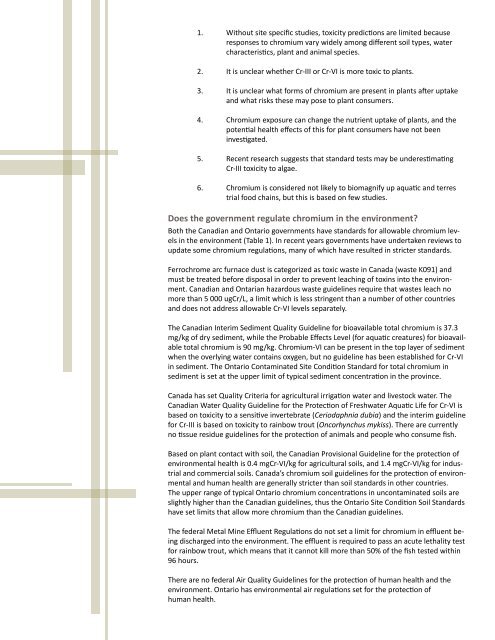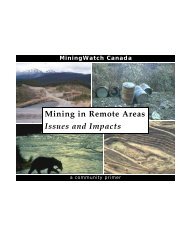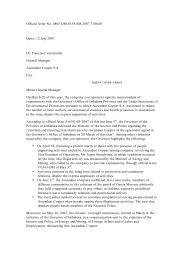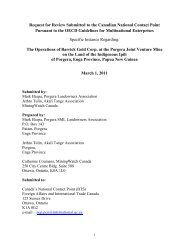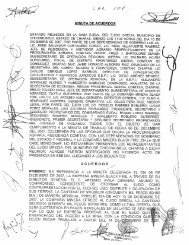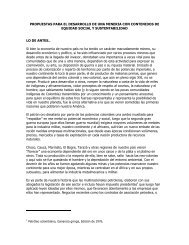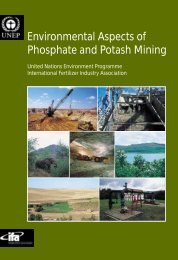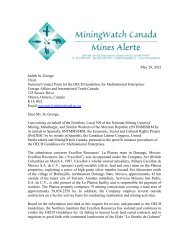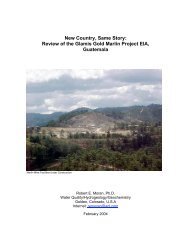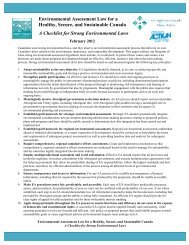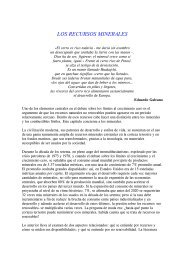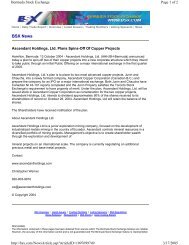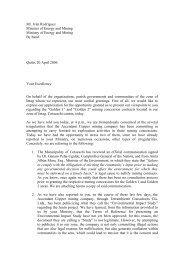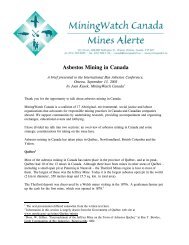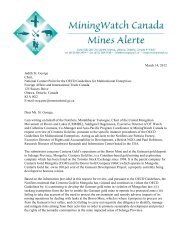Potential impacts of mining and processing chromite. Fact Sheet 1
Potential impacts of mining and processing chromite. Fact Sheet 1
Potential impacts of mining and processing chromite. Fact Sheet 1
Create successful ePaper yourself
Turn your PDF publications into a flip-book with our unique Google optimized e-Paper software.
1. Without site specific studies, toxicity predictions are limited because<br />
responses to chromium vary widely among different soil types, water<br />
characteristics, plant <strong>and</strong> animal species.<br />
2. It is unclear whether Cr-III or Cr-VI is more toxic to plants.<br />
3. It is unclear what forms <strong>of</strong> chromium are present in plants after uptake<br />
<strong>and</strong> what risks these may pose to plant consumers.<br />
4. Chromium exposure can change the nutrient uptake <strong>of</strong> plants, <strong>and</strong> the<br />
potential health effects <strong>of</strong> this for plant consumers have not been<br />
investigated.<br />
5. Recent research suggests that st<strong>and</strong>ard tests may be underestimating<br />
Cr-III toxicity to algae.<br />
6. Chromium is considered not likely to biomagnify up aquatic <strong>and</strong> terres<br />
trial food chains, but this is based on few studies.<br />
Does the government regulate chromium in the environment?<br />
Both the Canadian <strong>and</strong> Ontario governments have st<strong>and</strong>ards for allowable chromium levels<br />
in the environment (Table 1). In recent years governments have undertaken reviews to<br />
update some chromium regulations, many <strong>of</strong> which have resulted in stricter st<strong>and</strong>ards.<br />
Ferrochrome arc furnace dust is categorized as toxic waste in Canada (waste K091) <strong>and</strong><br />
must be treated before disposal in order to prevent leaching <strong>of</strong> toxins into the environment.<br />
Canadian <strong>and</strong> Ontarian hazardous waste guidelines require that wastes leach no<br />
more than 5 000 ugCr/L, a limit which is less stringent than a number <strong>of</strong> other countries<br />
<strong>and</strong> does not address allowable Cr-VI levels separately.<br />
The Canadian Interim Sediment Quality Guideline for bioavailable total chromium is 37.3<br />
mg/kg <strong>of</strong> dry sediment, while the Probable Effects Level (for aquatic creatures) for bioavailable<br />
total chromium is 90 mg/kg. Chromium-VI can be present in the top layer <strong>of</strong> sediment<br />
when the overlying water contains oxygen, but no guideline has been established for Cr-VI<br />
in sediment. The Ontario Contaminated Site Condition St<strong>and</strong>ard for total chromium in<br />
sediment is set at the upper limit <strong>of</strong> typical sediment concentration in the province.<br />
Canada has set Quality Criteria for agricultural irrigation water <strong>and</strong> livestock water. The<br />
Canadian Water Quality Guideline for the Protection <strong>of</strong> Freshwater Aquatic Life for Cr-VI is<br />
based on toxicity to a sensitive invertebrate (Ceriodaphnia dubia) <strong>and</strong> the interim guideline<br />
for Cr-III is based on toxicity to rainbow trout (Oncorhynchus mykiss). There are currently<br />
no tissue residue guidelines for the protection <strong>of</strong> animals <strong>and</strong> people who consume fish.<br />
Based on plant contact with soil, the Canadian Provisional Guideline for the protection <strong>of</strong><br />
environmental health is 0.4 mgCr-VI/kg for agricultural soils, <strong>and</strong> 1.4 mgCr-VI/kg for industrial<br />
<strong>and</strong> commercial soils. Canada’s chromium soil guidelines for the protection <strong>of</strong> environmental<br />
<strong>and</strong> human health are generally stricter than soil st<strong>and</strong>ards in other countries.<br />
The upper range <strong>of</strong> typical Ontario chromium concentrations in uncontaminated soils are<br />
slightly higher than the Canadian guidelines, thus the Ontario Site Condition Soil St<strong>and</strong>ards<br />
have set limits that allow more chromium than the Canadian guidelines.<br />
The federal Metal Mine Effluent Regulations do not set a limit for chromium in effluent being<br />
discharged into the environment. The effluent is required to pass an acute lethality test<br />
for rainbow trout, which means that it cannot kill more than 50% <strong>of</strong> the fish tested within<br />
96 hours.<br />
There are no federal Air Quality Guidelines for the protection <strong>of</strong> human health <strong>and</strong> the<br />
environment. Ontario has environmental air regulations set for the protection <strong>of</strong><br />
human health.


